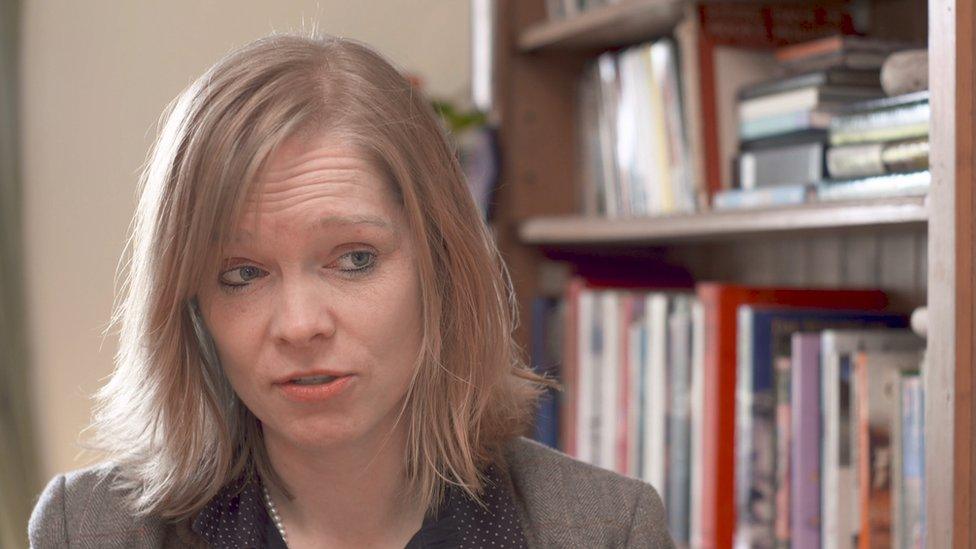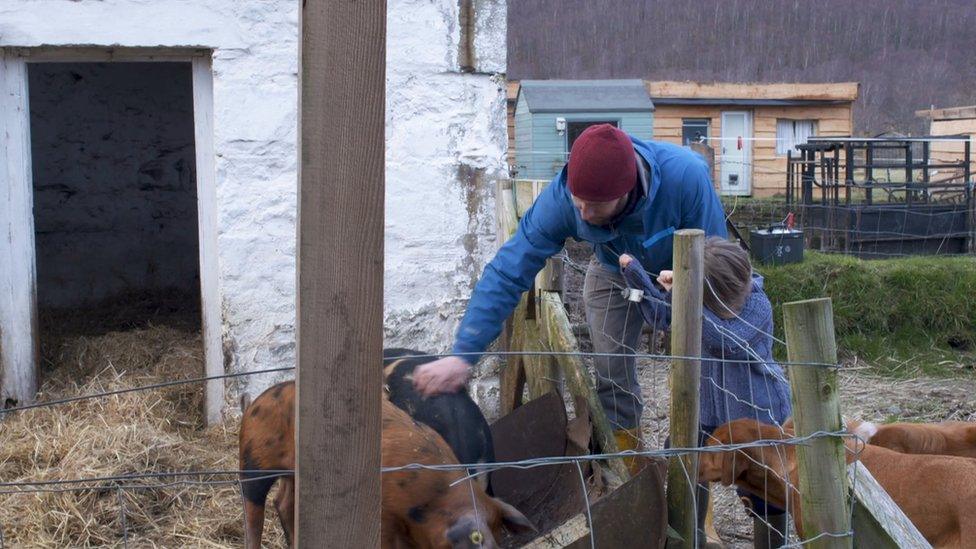Croft rules 'skewed against young people'
- Published

Sam Harrison and Karen Marshall hope to one day have their own croft
Crofting has existed in the Highlands and Islands for hundreds of years and is still very much alive today, but BBC Scotland's The Nine finds there are challenges to young people entering this traditional system of farming.
"All we want to do is croft," Karen Marshall told The Nine.
"But crofting isn't a permanent contract that you can go to a bank with and say: 'Can you give me a mortgage? I am a crofter. I will give you eggs every month. And slices of ham."
Crofting is a small-scale form of land tenure and food production unique to the Highlands and Islands, but increasingly croft land is becoming difficult to buy.
A croft is a piece of land sometimes rented from a land owner, and since the 1970s crofters have had a right to buy their crofts.

There are more than 20,000 registered crofts in Scotland
In order to acquire a croft, whether or not it is a tenancy or owner-occupied, the purchaser has to come up with 100% of the funds. There are no mortgages available to buy the land.
And if they were to de-croft part of it to get planning permission for a house and mortgage that piece of land, that pushes up the overall value of the land.
This means that the overall value of the land rises, and for some it has gone way beyond what they can afford.

Crofts in numbers
There are 20,777 crofts entered on the Crofting Commission's register of crofts
14,968 are tenanted and the remainder are owned
Most of these registered crofts - more than 9,900 - are in the Highlands
The Crofting Commission, which regulates and promotes the interests of crofting in Scotland, covers six areas: Argyll and Bute, Highlands, Orkney, Shetland, North Ayrshire (where there is one owned registered croft) and the Western Isles

In the past, crofters bought a tenancy. Since the 1970s they have had the chance to buy a croft outright and, should they wish, to develop their land, so the price of crofting land in general is rising.
This creates a problem for potential new young crofters, such as Karen and her partner Sam Harrison, who are unable to purchase a croft.
For the time being, Karen and Sam have got as close they can to living their dream by running The Sheiling Project, a crofting learning centre on land in Glen Strathfarrar at Struy, near Beauly.
Sam says: "It is a piece of land that we've got a 10-year lease for. It is not a croft and we don't have any long-term security for the tenure.
"That was the best situation we could have to start The Sheiling Project and actually get on with it rather than wait around forever and ever to find a piece of land that we could afford to buy."
Asked why they cannot afford to buy a croft, Sam laughs: "Because we are not paid enough."
'Different options'
He adds: "With The Sheiling Project we are increasingly making our own way as an organisation.
"We pay the staff more than we pay ourselves and we will continue to do that until we have got a sustainable business.
"So it's not a career where you are making enough money to be able to afford most croft prices as they are."

Stefanie Rothgeldard runs a croft in Ross-shire
Meanwhile, those who do have crofts are diversifying the business.
Stefanie Rothgeldard runs a croft in Ross-shire.
"We have a flock of chickens, we've got ponies and dogs. It's all the usual croft animals. This is just one side of the business, running the cattle and sheep," she says.
"But that is not what is sustaining us. We also have an Airbnb. These days if you want to make a living off a croft you have to diversify and you have to look at different options."
But Stefanie says that she and her husband Tom needed help from their croft's previous owners, their own parents and own savings to acquire the croft.
'Level the playing field'
Eilidh MacLellan, a crofting law consultant, argues crofting could be made more accessible to new entrants.
She says: "In my opinion the most effective measures the government could take would be to consider removing the right of crofters to purchase their crofts.
"And to consider making available, specific to crofters or prospective crofters, a source of funding which could be a loan rather than grant funding to enable young people to access some sort of finance to assist them.
"Both these measures would level the playing field, which at the moment seems terribly skewed against young people."

Eilidh MacLellan, an expert on crofting law, says the industry could be made more accessible to new entrants
The Scottish government says it recognises that attracting new entrants to crofting is critical to its future.
It currently has three schemes open to help improve croft houses,
These are the Croft House Grant which provides grants to build, improve and maintain the standard of crofter housing.
The Crofting Agricultural Grant Scheme is designed to aid and develop agricultural production. Items eligible for grant aid include, the erection of agricultural buildings, drainage and fencing.
Crofters also have access to the Self Build Loan Fund.
The government did have the New Entrant Start-up Grant, which could have been put towards getting land, but at the moment there is no scheme open. The government says it has not ruled out reopening the scheme in the future.

The Shieling Project is closest to a croft life Sam Harrison has at the moment